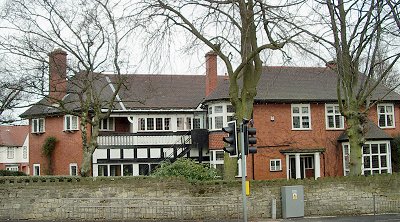|

Listing: This building was locally listed in
March 2003 as a spot listing.
Comment: The house was built for Walter
Careless in 1909. The architect was the Wolverhampton architect
William Johnson Harrison Weller, who also designed The Spinney and
Longfield both of which are nationally listed - as is another of his
houses in Burnhill Green, South Staffordshire.
In August 2002 developers indicated that they wished to
redevelop this site and to demolish the building entirely. The
city council indicated that they wanted the house preserved and asked
the Department for Culture Media and Sport for statutory listing.
The council pointed out, inter alia, that the exterior had only had
minor alterations, other than a two storey, flat roofed extension.
[That extension is to the right in the photo above, which shows that the
extension does not affect the original appearance of the main facade].
The council also pointed out that the interior contains many original
features such as fireplaces, panelled and leaded light doors, window
seating, plate rails, stained glass and pierced staircase balusters.
The Inspector's report to the DCMS said, inter alia, that
"Weller is not a well-known name: he typifies the highly competent local
Edwardian practitioner who was able to design in a convincingly
fashionable manner by drawing on the many publications and journals then
disseminating the new architecture." It refers to the interesting
features both internal and external but concludes: "The impact of
the large eastern extension is unfortunate, as it seriously compromises
the building's integrity. The house is more successful in terms of
individual elements, rather than as an overall design: it is the motifs
and features which please, rather than the cumulative effect". It
then goes on to point out that by 1909 "many leading architects were
moving away from the Arts and Crafts towards the Baroque Revival and the
rising Neo-Georgian manner. Weller was essentially a reactive
designer, following established styles rather than pursuing his own".
Perhaps it is somewhat more than nit picking to point out
that if Weller got his ideas from journals which were "disseminating the
new architecture" it is surprising that his style was passé when
compared with Baroque Revival and Neo-Georgian. But it seems to be
part of the DCMS policy that you only list early examples or the way
out. Locally of course we can take an approach which is based more
in history than in neophilia. The local listing recognises that
Weller was a good architect doing a good job, influenced by others as
every architect is. It recognises that this building is
historically important as evidence of the wealth, status and tastes of
local magnates. And that it has "motifs and features which
please". And that a building does not become less worthy of
preservation because of what was built next door. Baron's Court
has made a pleasing contribution to the local scene for nearly a century
now and could do so far into the future.
The position now is that planning permission has been
refused for a scheme which demolished the building and over-developed
and inappropriately developed the site. The developers are now
thinking again, with a clear indication that a proposal which involved
preserving the building has a much better chance of success. One
of Weller's other buildings, the Spinney, has been the subject of a
successful scheme of that sort. We live in hope.

|